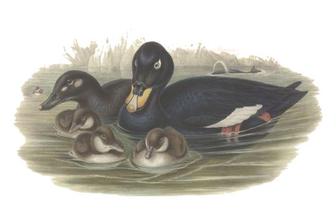Velvet Scoter
It winters further south in temperate zones, Europe as far south as Great Britain, and on the Black and Caspian Sea. Small numbers reach France and northern Spain. It forms large flocks on suitable coastal waters. These are tightly packed, and the birds tend to take off together.

The Velvet Scoter is classified as Least Concern. Does not qualify for a more at risk category. Widespread and abundant taxa are included in this category.
The Velvet Scoter is one of the species to which the Agreement on the Conservation of African-Eurasian Migratory Waterbirds (AEWA) applies. References - * BirdLife International (2004). Melanitta fusca. 2006. IUCN Red List of Threatened Species. IUCN 2006. www.iucnredlist.org. Retrieved on 11 May 2006. More
Male Velvet Scoters can be identified at close range by the neat white 'tear drop' just behind the eye, the greater extent of yellow in the bill (around the edges not just in the centre) and by occasional glimpses of the white patch in the closed wing. Females are like Common Scoters but have all dark heads apart from two small, vague, pale blotches, one behind the bill, and another behind the eye. More
The Velvet Scoter (Melanitta fusca) is a large sea duck, which breeds over the far north of Europe and Asia west of the Yenisey basin. A small, isolated population nests in eastern Turkey. The East Siberian and North American White-winged Scoter is sometimes considered conspecific (of, or belonging to, the same species) with the Velvet Scoter, and its two constituent subspecies are then known as M. f. stejnegeri and M. f. deglandi. More
The velvet scoter is a black seaduck. It has a long bill, a thick neck and a pointed tail. In flight, it shows a white patch on the rear of the wing - this can also be seen when birds sitting on the sea flap their wings. This species does not breed in the UK, but is a winter visitor to the east coast, especially in Scotland, Norfolk and north-east England. The large flocks in winter are vulnerable to oil pollution and depleted fish stocks. More
Velvet Scoter determination Similar species Anatidae American Wigeon | Baikal Teal | Bar-Headed Goose | Barnacle Goose | Barrows Goldeneye | Bean Goose | Black Swan | Blue-Winged Teal | Brent Goose | Bufflehead | Cackling Goose | Canada Goose | Canvasback | Common Scoter | Egyptian Goose | Eider | Falcated Duck | More
The Velvet Scoter (Melanitta fusca) is a large sea duck, which breeds over the far north of Europe, Asia and North America, where it is known as the White-winged Scoter. It winters further south in temperate zones, on the Great Lakes, the coasts of the northern USA and the southern coasts of Canada, Europe as far south as Great Britain, and Asia as far south as China. It forms large flocks on suitable coastal waters. More
The Velvet Scoter (Melanitta fusca) is a large sea duck, which breeds over the far north of Europe and Asia west of the Yenisey basin. A small, isolated population nests in eastern Turkey. More
Six velvet scoters were among a huge flock of common scoters off Llanddulas and up to eight great northern divers at Aberdesach and Pontllyfni, where an adult Mediterranean gull lingered.gardening: bird notes by Daily Post (Liverpool, England)Among the ever-increasing numbers observed were the velvet scoter, red kite, kingfishers, cuckoos, buzzards and the spotted redshank.Huntsman's marshland site is a winner by Evening Gazette (Middlesbrough, England)off Llanfairfechan and 12 velvet scoters were reported off Llanddulas. More
05 Velvet scoter in the Baltic Sea = BEF0rum 20 vidéos S'abonnerModifier l'abonnement Chargement… 24 vues 24 vues BEF0rum — 12 juin 2009 — The Eastern Baltic Sea has not only natural and historical values, of which we might not know, but it also faces... More
Velvet Scoter records in the Western Isles Scarce passage visitor or winter visitor (very small numbers recorded in most years, & fewer since 1980's) Source: Outer Hebrides Bird Report (2001) Taransay sound is a good site to see the Velvet Scoter in autumn - winter. More
Velvet Scoter remain 3rd May 2010 – bright and sunny N1/2/3 Offshore Two drake Velvet Scoter remain but otherwise it was generally quiet over the sea with just small numbers of Sandwich Tern, Gannet, Red-throated Diver and Common Scoter logged. Grounded Migrants There was little evidence of any newly grounded birds with 15 Wheatear, 2 White Wagtail and single Willow Warbler and Blackcap considered lingering birds from previous days. More
The immature Surf and Velvet Scoter remain offshore. Thursday 29th: The Surf and Velvet Scoter remain offshore with 51 shelduck and 11 Little Egret in the estuary. Wednesday 28th: There was no sign of either scoter today but a Slavonian and 30+ Great-crested Grebe were on the sea along with two Red-throated Diver. Also offshore 80+ Gannet, 50+ Kittiwake and 40+ Razorbill. In the estuary there were 751 Wigeon, 298 Redshank, 40 Teal and two Greenshank. More
female Velvet Scoter, also seen were 85 Razorbill, 23 Red-breasted Merganser, 23 Red-throated Diver, 21 Common Scoter, 18 Gannet, 13 Kittiwake, 8 Sandwich Tern, 3 Shag and 2 Guillemot Grounded Migrants Limited to 5 Wheatear. Diurnal Migration A Siskin flew through and small numbers of Meadow Pipit and alba Wagtail remain on the move. Mammals Both Stoat and Hare were seen. Moths Hebrew Character and Common Quaker were new for the year. More
Long-tailed Duck, Velvet Scoter- 6 and 3 in Largo bay Red-breasted Merganser- double figures in Largo bay, individuals on Lochs Goosander- pairs around Loch Morlich and Loch an Eilein Capercaillie- 1, displaying male, Loch Garten Caperwatch Black Grouse-... More

Original source: Dave Spier
Author: Dave Spier
Permission: Some rights reserved
Family : Anatidae
Genus : Melanitta
Species : fusca
Authority : (Linnaeus, 1758)
